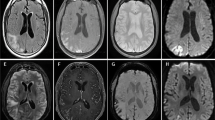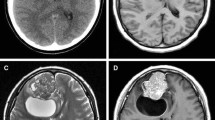Summary
Meningioangiomatosis (MA) is a rare malformative lesion of the central nervous system. It has generally been thought that the main cells forming this lesion are derived from arachnoidal cap cells. We report a case of MA in which histochemical, immunoperoxidase and electron microscopic studies did not support a meningothelial origin of this lesion. Rather, the lesion in this case appears to be a vascular malformation with the dominant cells being fibroblastic, derived from vessel walls; however, their origin from arachnoid cap cells that differentiated into fibroblast-like cells could not be totally ruled out. Residual neurons within the lesion contained neurofibrillary tangles with ultrastructural and immunostaining properties identical to those seen in Alzheimer's disease except for the absence of A4 amyloid.
Similar content being viewed by others
References
Bassoe P, Nuzum F (1915) Report of a case of central and peripheral neurofibromatosis. J Nerv Ment Dis 42:785–796
Binder LI, Frankfurter A, Rebhun LI (1985) The distribution of tau in the mammalian central nervous system. J Cell Biol 101:1371–1378
Braak H, Braak E (1988) Neuropil threads occur in dendrites of tangle-bearing nerve cells. Neuropathol Appl Neurobiol 14:39–44
Braak H, Braak E, Grundke-Iqbal I, Iqbal K (1986) Occurrence of neuropil threads in the senile human brains and in Alzheimer's disease: a third localization of paired helical filaments outside of neurofibrillary tangles and neuritic plaques. Neurosci Lett 65:351–355
Crapper-McLachlan DR, Krishnan SS, Quittkat S, De Boni U (1980) Brain aluminium in Alzheimer's disease: influence of sample size and case selection. Neurotoxicology 1:25–32
Dickson DW, Yen SH (1989) Beta-amyloid deposition and paired helical filament formation: which histopathological feature is more significant in Alzheimer's disease. Neurobiol Aging 10:402–404
Dickson DW, Ksiezak-Reding H, Crowe A, Yen SH (1987) A monoclonal antibody that recognizes a phosphorylated epitope in Alzheimer neurofibrillary tangles, neurofilament and tau proteins immunostains granulovacuolar degeneration. Acta Neuropathol (Berl) 73:254–258
Dickson DW, Farlo J, Davies P, Crystal H, Fuld P, Yen S-HC (1988) Alzheimer's disease: a double-labeling immunohistochemical study of senile plaques. Am J Pathol 132:86–101
Dickson DW, Crystal H, Mattiace LA, Kress Y, Schwagerl A, Davies P, Yen SH (1989) Diffuse Lewy body disease: light and electron microscopic immunocytochemistry of senile plaques. Acta Neuropathol 78:572–584
Dickson DW, Wertkin A, Kress Y, Ksiezak-Reding H, Yen SH (1990) Ubiquitin-immunoreactive structures in normal brains: distribution and developmental aspects. Lab Invest 63:87–99
Halper J, Scheithauer BW, Okazaki H, Laws ER (1986) Meningio-angiomatosis: a report of six cases with special reference to the occurrence of neurofibrillary tangles. J Neuropathol Exp Neurol 45:426–446
Ihara Y (1988) Massive somatodendritic sprouting of cortical neurons in Alzheimer's disease. Brain Res 459:138–144
Johnson PC, Nielsen SL (1976) Localized neurofibrillary degeneration in vascular malformations (abstract). J Neuropathol Exp Neurol 35:300
Kasantikul V, Brown WJ (1981) Meningioangiomatosis in the absence of von Recklinghausen's disease. Surg Neurol 15:71–75
Kitamoto T, Ogomori K, Tateishi J, Prusiner SB (1987) Formic acid pretreatment enhances immunostaining of cerebral and systemic amyloids. Lab Invest 57:230–236
Kowall NW, Kosik KS (1987) Axonal disruption and aberrant localization of tau protein characterize the neuropil pathology of Alzheimer's disease. Ann Neurol 22:639–643
Ksiezak-Reding H, Dickson DW, Davies P, Yen SH (1987) Recognition of tau epitopes by anti-neurofilament antibodies that stain Alzheimer neurofibrillary tangles. Proc Natl Acad Sci USA 84:3410–3414
Kunishio K, Yamamoto Y, Sunami N, et al. (1987) Histopathologic investigation of a case of meningioangiomatosis not associated with von Recklinghausen's disease. Surg Neurol 27:575–579
Lee S, Park YD, Yen S-H, Ksiezak-Reding H, Goldman JE, Dickson DW (1989) Infantile motor neuron disease: a case report with electron microscopic and ubiquitin and neurofilament immunohistochemical studies. Neuropediatrics 20:107–111
Liss L, Ebner K, Couri D (1979) Neurofibrillary tangles induced by a sclerosing angioma. Hum Pathol 10:104–108
Liu SS, Johnson PC, Sonntag VKH (1989) Meningioangiomatosis: a case report. Surg Neurol 31:376–380
Meis JM, Ordonez NG, Bruner Jm (1986) Meningiomas: an immunohistochemical study of 50 cases. Arch Pathol Lab Med 110:934–937
Ogilvy CS, Chapman PH, Gray M, de la Monte SM (1989) Meningioangiomatosis in a patient without von Recklinghausen's disease. J Neurosurg 70:483–485
Paulus W, Peiffer J, Roggendorf W (1989) Meningio-Angiomatosis. Pathol Res Pract 184:446–452
Probst A, Anderton BH, Brion J-P, Ulrich J (1989) Senile plaque neurites fail to demonstrate anti-paired helical filament and anti-microtubule-associated protein-tau immunoreactive proteins in the absence of neurofibrillary tangles in the neocortex. Acta Neuropathol 77:430–436
Russell DS, Rubinstein LJ (1989) Pathology of tumors of the central nervous system, 5th edn. Williams and Wilkins, Baltimore, pp 777–779
Sakaki S, Nakagawa K, Nakamura K, Takeda S (1987) Meningioangiomatosis not associated with von Recklinghausen's disease. Neurosurgery 20:797–801
Schnitt SJ, Vogel H (1986) Meningiomas: diagnostic value of immunoperoxidase staining for epithelial membrane antigen. Am J Surg Pathol 10:640–649
Winek RR, Scheithauer BW, Wick MR (1989) Meningioma, meningeal hemangiopericytoma (angioblastic menigioma), peripheral hemangiopericytoma, and acoustic schwannoma: a comparative immunoshistochemical study. Am J Surg Pathol 13:251–261
Wolozin BL, Pruchnicki A, Dickson DW, Davies P (1986) A neuronal antigen in the brain of Alzheimer patients. Science 232:648–650
Worster-Drought C, Dickson WEC, McMenemey WH (1937) Multiple meningeal and perineural tumours with analogous changes in the glia and ependyma (neurofibroblastomatosis). Brain 60:85–117
Yen S-H, Crowe A, Dickson DW (1985) Monoclonal antibodies to Alzheimer neurofibrillary tangles. 1. Identification of polypeptides. Am J Pathol 120:282–291
Author information
Authors and Affiliations
Rights and permissions
About this article
Cite this article
Goates, J.J., Dickson, D.W. & Horoupian, D.S. Meningioangiomatosis: an immunocytochemical study. Acta Neuropathol 82, 527–532 (1991). https://doi.org/10.1007/BF00293390
Received:
Revised:
Accepted:
Issue Date:
DOI: https://doi.org/10.1007/BF00293390




